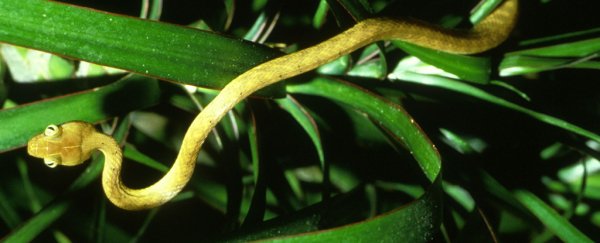In case you're unfamiliar with Guam's infamous 'snake problem', the island is known for hosting an invasion of venomous brown snakes that have wreaked havoc on its native animal population.
Now researchers have shown it's not just the birds and rodents that have suffered – the growth of new trees could be falling by as much as 92 percent thanks to the snakes' appetites.
The tiny 544-square-kilometre (210-square-mile) island of Guam is a US territory sitting somewhat halfway between Australia and Japan, and is famous for being captured by the Japanese in World War II before being freed by American forces in 1944.
Its other item of notoriety is the fact it happens to be dripping with brown tree snakes (Boiga irregularis) that appeared roughly around the time of the island's liberation - most likely after hitching a ride with US military equipment from the neighbouring Papua New Guinea.
The species isn't overly dangerous to humans, though its venomous bite packs a punch on the small animals it preys upon.
Since the wildlife on Guam evolved without these kinds of scaly predators snacking on their eggs and young, the forests provided a veritable smorgasbord for the invaders, causing the population to expand to a whopping 2 million snakes, with densities of up to 5,000 individuals per square kilometre (or 13,000 per square mile).
Just to really creep out those with a serious case of ophiophobia (that's a fear of serpents), the snakes are so plentiful that the damage they've caused by shorting out electrical systems alone adds up to about $US4.5 million over the past seven years.
Yet it's the ecosystem that has suffered the most – by the mid-1980s, 10 of the 12 bird species native to Guam had vanished, including a kingfisher that can't be found anywhere else on Earth.
Researcher Haldre Rogers from from the University of Colorado says the bird song that echoes on neighbouring islands has fallen oddly quiet on Guam: "On Guam, it's silent – it's an eerie feeling."
Now it seems the ravaging of the island's bird-life has had a knock-on effect on the surrounding tree population, according to new study by Rogers and her team.
The researchers placed large baskets beneath two species of tree throughout the forests on Guam and several nearby islands, keen to know how far the fruiting trees spread their seeds across the forest floor.
On Guam, fewer than 10 percent of the seeds made it beyond the immediate vicinity of their parent tree, compared with 60 percent of the seeds on the snake-free islands.
"Aside from fruit bats, which are also nearly extinct on Guam, nothing else can disperse seeds," said Rogers.
With more than two-thirds of the island's trees relying on animals to distribute and germinate their seeds, the impact of the reduction is expected to be a devastating drop of between 61 and 92 percent in new forest growth.
In recent years, the US Department of Agriculture has engaged in chemical warfare with the snakes in an $US8 million eradication program.
Their weapon of choice is a dose of paracetamol, also known as acetaminophen, which is toxic to many animals – including brown snakes.
Rather than convince 2 million reptiles they had a headache, the program parachuted thousands of dead mice laced with the drug into the forests, where they hung from the branches until a snake hankering for a snack slithered by.
Early research shows the snakes do take the bait, but it's early days, so no news yet on how much of an impact the past couple of years of the program has had.
Since Guam is home to a number of military bases and has a large port, the fear is that snakes could once again hitch a ride to another island and cause a similar cascade of problems.
This research was published in Nature Communications.
